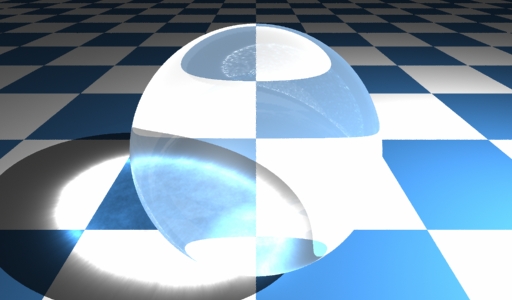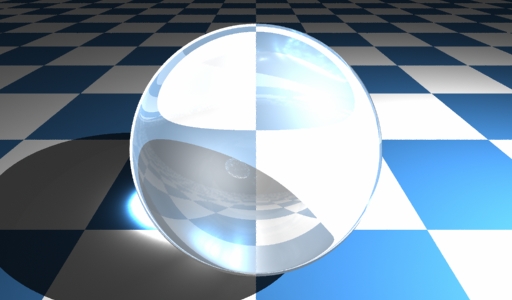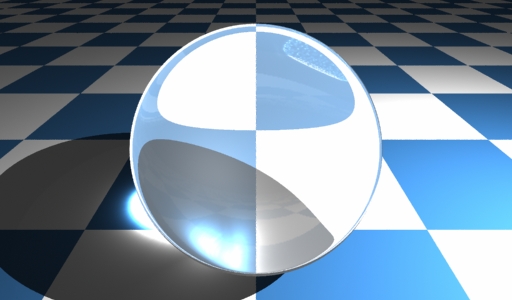コースティクス(集光模様)を入れるためにラジオシティのスイッチを入れる。記述の最後の行のひとつ上に
s.radiosity()
を加える。
質感は以下のように設定した。屈折率を調整すると面白い。
plastic = s.newMaterial( "standard",[ "kc", vector3( 0.2, 0.2, 0.2 ),"kd", 0.01 ,"kr",vector3(0.2,0.2,0.2),"kt",vector3(0.8,0.8,0.8),"IOR",1.26,"caustics", 4, 4] )

#! /usr/bin/env python
from lightflowPM import *
from math import *
s = scene()
s.lightOn( s.newLight( "point", [ "position", vector3( 5.0, -2.0, 5.0 ), "color", vector3( 300.0, 300.0, 300.0 ) ] ) )
s.lightOn( s.newLight( "ambient", [ "color", vector3( 0.2, 0.2, 0.2 ) ] ) ) #環境光を加える。
plastic = s.newMaterial( "standard",[ "kc", vector3( 0.2, 0.2, 0.2 ),"kd", 0.01 ,"kr",vector3(0.2,0.2,0.2),"kt",vector3(0.8,0.8,0.8),"IOR",1.26,"caustics", 4, 4] )
plastic2 = s.newMaterial( "standard",[ "kt",vector3(0.95,0.95,0.95), "kr",vector3(0.05,0.05,0.05), "kd",0.01, "IOR",1.26,"caustics", 4, 4] )
plastic3 = s.newMaterial( "standard",[ "kt",vector3(0.85,0.85,0.85), "kr",vector3(0.15,0.15,0.15), "kd",0.01, "IOR",1.15,"transmission",1,"radiosity",1 ] )
check_ground=s.newPattern("check",["color",vector3( 0.2, 0.4, 0.6),"scale",0.025])
ground=s.newMaterial( "standard",[ "kc", check_ground,"kc",vector3( 1.0, 1.0, 1.0 ),"ka",check_ground ] )
#ground=s.newMaterial( "standard",[ "kc", vector3( 1, 1, 1 ) ] ) #白
s.materialBegin( plastic1 )
s.addObject( s.newObject( "sphere", [ "radius",1.4] ) )
s.materialEnd()
#地面groundをpatchで作成しています。高さ(z軸)を-1.4にしてぴったり球とあわせています。
s.materialBegin( ground )
s.addObject( s.newObject( "patch", [ "points",vector3( -50, -50, -1.4 ),vector3( -50, 50, -1.4 ),vector3( 50, -50, -1.4 ),vector3( 50, 50, -1.4 )] ) )
s.materialEnd()
saver = s.newImager( "tga-saver", [ "file", "sphere_glass04.tga" ] )
s.imagerBegin( saver )
camera = s.newCamera( "pinhole", [ "eye", vector3( 0, -3, 2 ), "aim", vector3( 0, 0, 0 ) ] )
s.imagerEnd()
s.radiosity()
s.render( camera, 512, 300 )
以下のようにファイル出力するようにした。
idx=[1.05,1.1,1.15,1.2,1.22,1.24,1.26,1.28,1.3,1.4]
10個の屈折率を割り当てて10枚出力する


#! /usr/bin/env python
from lightflowPM import *
from math import *
for f in range(10):
s = scene()
s.lightOn( s.newLight( "point", [ "position", vector3( 5.0, -2.0, 5.0 ), "color", vector3( 300.0, 300.0, 300.0 ) ] ) )
s.lightOn( s.newLight( "ambient", [ "color", vector3( 0.2, 0.2, 0.2 ) ] ) ) #環境光を加える。
idx=[1.05,1.1,1.15,1.2,1.22,1.24,1.26,1.28,1.3,1.4]
plastic = s.newMaterial( "standard",[ "kc", vector3( 0.2, 0.2, 0.2 ),"kd", 0.01 ,"kr",vector3(0.2,0.2,0.2),"kt",vector3(0.8,0.8,0.8),"IOR",idx[f],"caustics", 4, 4] )
plastic2 = s.newMaterial( "standard",[ "kt",vector3(0.95,0.95,0.95), "kr",vector3(0.05,0.05,0.05), "kd",0.01, "IOR",1.26,"caustics", 4, 4] )
plastic3 = s.newMaterial( "standard",[ "kt",vector3(0.85,0.85,0.85), "kr",vector3(0.15,0.15,0.15), "kd",0.01, "IOR",1.15,"transmission",1,"radiosity",1 ] )
check_ground=s.newPattern("check",["color",vector3( 0.2, 0.4, 0.6),"scale",0.025])
ground=s.newMaterial( "standard",[ "kc", check_ground,"kc",vector3( 1.0, 1.0, 1.0 ),"ka",check_ground ] )
#ground=s.newMaterial( "standard",[ "kc", vector3( 1, 1, 1 ) ] ) #白
s.materialBegin( plastic )
s.addObject( s.newObject( "sphere", [ "radius",1.4] ) )
s.materialEnd()
#地面groundをpatchで作成しています。高さ(z軸)を-1.4にしてぴったり球とあわせています。
s.materialBegin( ground )
s.addObject( s.newObject( "patch", [ "points",vector3( -50, -50, -1.4 ),vector3( -50, 50, -1.4 ),vector3( 50, -50, -1.4 ),vector3( 50, 50, -1.4 )] ) )
s.materialEnd()
saver = s.newImager( "tga-saver", [ "file", ("sphere_glass_%03d" % f)+".tga" ] )
s.imagerBegin( saver )
camera = s.newCamera( "pinhole", [ "eye", vector3( 0, -3, 2 ), "aim", vector3( 0, 0, 0 ) ] )
s.imagerEnd()
s.radiosity()
s.render( camera, 512, 300 )
Improper indentation.
mqo pythonでエラー表示。
いろんなサイトで公開されているスクリプトをこぴぺして実行しようとしたら、上記のエラー
Improper indentation.
メタセコイアのスクリプトエディタで表示された。
どの行かも、黄色で表示される。
EmEditorで編集してみたら、
関数def部分のインデントが空白行とタブが混在していることがわかった。
よって。エディタでタブに統一した。
Metasequoia(メタセコイア)でpythonスクリプトを読み込んで実行したら、できました。
ありがとうございます。


